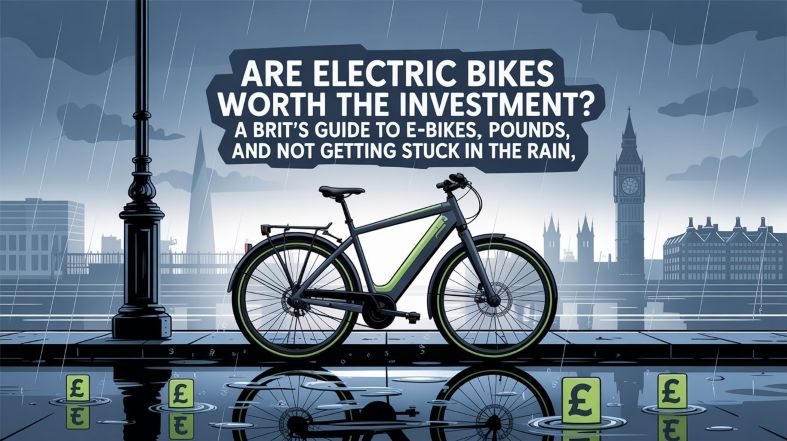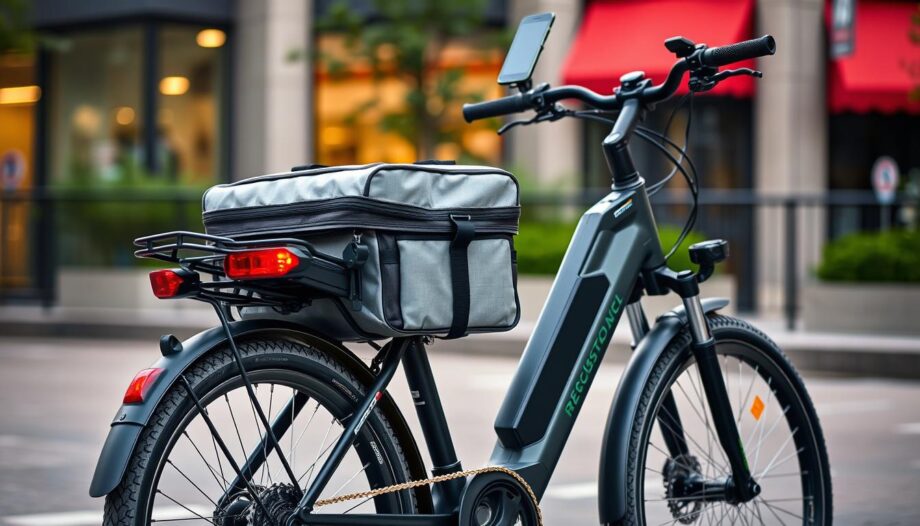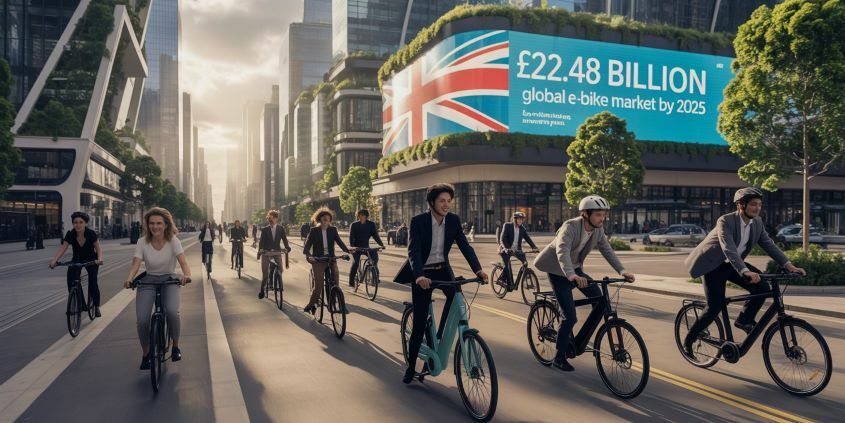When it comes to commuting, are you team electric bike or team public transport? It’s a debate many of us face as we navigate our busy lives in the UK. Both options have their strengths and weaknesses, but with rising costs in public transport and growing concerns about our environmental footprint, the allure of a two-wheeled ride is becoming hard to ignore. Electric bikes not only speed up travel times and cut long-term costs, but they also provide a chance to enjoy the open air while getting from point A to B. Yet, public transport has its appeal too also no parking costs it can be more accommodating for those with mobility challenges and offers a cosy way to escape the unpredictable British weather. Let’s dive into the pros and cons of each option to understand better what suits our needs and lifestyles.
Electric bikes offer advantages such as faster travel times, cost-effectiveness over long-term use, and greater convenience by allowing direct routes without waiting for public transport. However, they face challenges like weather conditions affecting safety and accessibility for individuals with disabilities; conversely, public transport can accommodate higher passenger volumes but may be slower due to waiting times and limited services during off-peak hours.
If you want to do some calculations you can use the calculator provided and fill in the boxes with your costs, also check out our range calculator
When I say public transport I mean bus, train and tram and also the underground in London, I have average costs per month further down the page
| Transport Mode | Estimated Monthly Cost (£) | Annual Cost (£) |
|---|---|---|
| Bus (London) | £100 | £1,200 |
| Bus (Outside London) | £120 | £1,440 |
| Bus (Manchester) | £80 | £960 |
| Tram (Manchester) | £50 | £600 |
| Tram (Sheffield) | £60 | £720 |
| London Underground | £300 | £3,600 |
| National Rail | £821.40 (London) / £600+ (UK Avg) | £9,856.80 (London) / £7,200+ (UK Avg) |
| Electric Bike | £100-£200 (one-time cost) | £0-£100 (maintenance and charging) |
Switching to an electric bike can lead to significant savings over time. Compared to public transport:
- Monthly savings range from £50 to £821, depending on your usual commute.
- Annual savings range from £500 to £9,756, with the highest savings for National Rail commuters in London.
- Over 5 years, an e-bike could save you between £2,500 and £49,000, making it a cost-effective alternative.
Summary of Pros and Cons
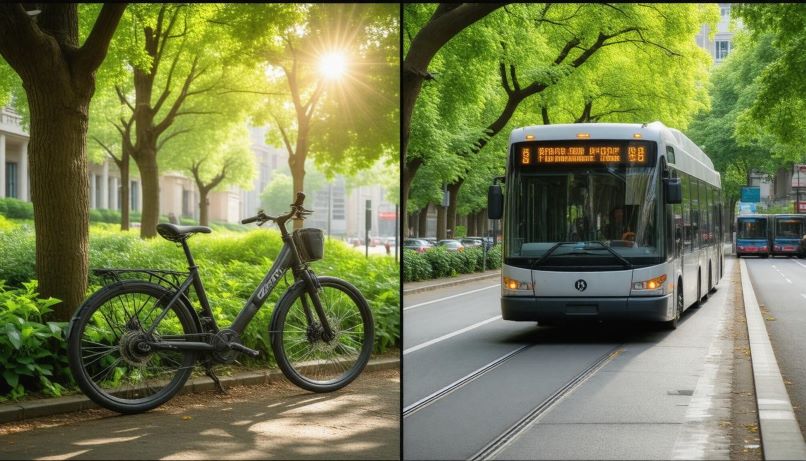
Summarizing the essential factors makes it much easier to see the bigger picture when evaluating electric bikes versus public transport. Let’s examine what each mode of transportation offers while considering significant criteria that can influence our decision-making.
| Criteria | Electric Bikes | Public Transport |
|---|---|---|
| Environmental Impact | Lower emissions – eBikes significantly reduce our carbon footprint, making them a greener choice for short trips. | Moderate emissions – While still better than single-occupant vehicles, public transport is not as eco-friendly as eBikes. |
| Cost | High upfront, low long-term – The initial purchase might be substantial (ranging from £500 to £3,000), but maintenance and operating costs are minimal, averaging about £0.01 to £0.05 per mile. | Recurring monthly expense – With average fares around £2.50 per bus ride, public transport can add up over time unless we leverage daily and weekly caps or discounts like student railcards. |
| Convenience | High flexibility – eBikes allow us the freedom to choose routes without being tethered to fixed stops or schedules. | High accessibility – Buses and trains cover extensive networks, providing access to various destinations even if they aren’t entirely convenient. |
| Urban Infrastructure | Low investment – Cycling infrastructure may vary by area, but eBike riders often require minimal investment in cycling lanes compared to public transport systems. | High investment – Public transport relies on extensive funding for its infrastructure and maintenance, which can lead to delays or unavailability during off-peak hours. |
| Comfort | Weather dependent – Riding in rain or snow can severely impact comfort levels; appropriate gear is essential to stay dry and warm. | Generally high – Trains and buses typically offer comfortable seating and protection from the elements, though overcrowding can lead to discomfort during peak hours. |
| Safety | Traffic risks – Cyclists face hazards from traffic, requiring vigilance and potential investment in helmets and insurance for added security. | Lower personal risks – Public transit provides greater safety in terms of accidents as passengers aren’t responsible for steering through congested urban streets. |
| Efficiency | Often faster – Many users report quicker travel times on short trips due to avoiding stops and traffic congestion with their eBikes. | Subject to delays – Public transport timing can be erratic due to waits for buses or train delays, impacting overall efficiency compared to cycling. |
| Health Benefits | High – Regular biking promotes fitness, with each ride providing at least thirty minutes of exercise, greatly enhancing overall health. | Low – While riding public transport involves some physical activity, it generally engages less than experienced through cycling. |
Considering these points allows all potential users to make a more informed choice tailored specifically to their needs when choosing between an electric bike or public transport for their daily commute. Weighing the benefits alongside any drawbacks will better equip us for finding the right transportation solution suited for our lifestyles.
Some More details
When weighing the costs of electric bikes against public transport, we realize it’s more than just a simple price tag.
For many of us, the initial costs can feel daunting. E-bikes generally range from £500 to £3,500, while a monthly public transport pass typically falls between £60 and £150 depending on where we are in the UK. Although this suggests that e-bikes require a considerable upfront investment, it also brings us to think about the long-term value they offer.
Over an entire year, for someone using public transport at £100 a month, we’d be looking at a whopping £1,200. In contrast, once we’ve purchased our electric bike, our primary ongoing expense would just involve maintenance approximately £100 per year. This is where we start to see a significant difference in overall expenditure.
We might find ourselves drawn to the idea of ownership and independence with an electric bike. The one-time purchase not only frees us from daily fare charges but also allows for flexible travel without waiting for buses or trains. It gives us the freedom to commute as often as needed without worrying about recurring costs.
However, it’s crucial to consider usage frequency; for those who don’t commute regularly or whose trips are sporadic, public transport might end up being more economical.
For instance, if we were to use public transport only a few times a week, the cost could become less burdensome compared to committing to an e-bike purchase. On average, light users could spend much less on occasional transport than maintaining an electric bike. Thus, understanding our commuting habits and calculating expenses based on our unique lifestyle becomes key in deciding which option is best.
Additionally, there are factors beyond sheer cost that play a role in this decision-making process. Maintenance costs for e-bikes may not seem excessive at around £100 annually, but unexpected repairs could arise, especially if we rely heavily on them for daily use.
In contrast, we can count on public transport’s predictable schedule and structure. It might lack the personal touch and freedom of cycling, yet it does offer stability.
As we explore these aspects further, it’s essential to remember how convenience and accessibility can shape our commuting experience. Understanding these elements will help us navigate our daily journeys effectively.
Daily Convenience and Accessibility
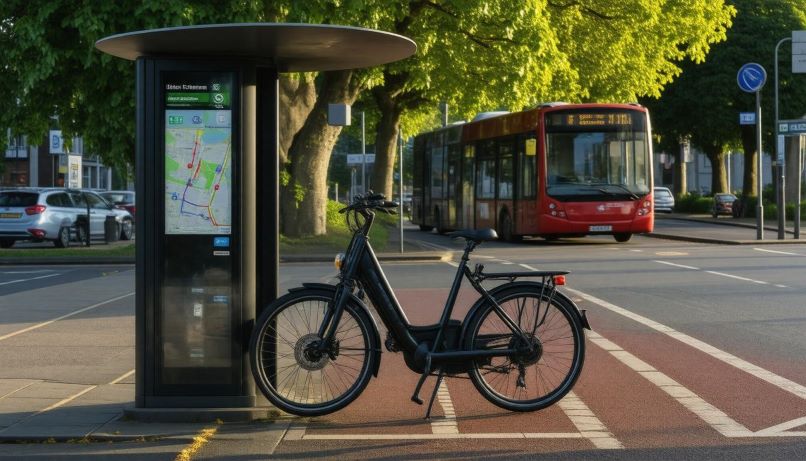
When we think about convenience in our daily commutes, electric bikes (eBikes) shine brightly. They offer us the freedom to hop on at a moment’s notice without waiting for a bus or train, allowing us to set our own schedules. This spontaneity is particularly appealing for those with unpredictable work hours or spontaneous plans. Imagine no longer being tied to the fixed timetables of public transport; instead, we glide quietly down the road, choosing direct routes that zip us from our front doors to our destinations.
Yet, while eBikes provide this autonomous travel experience, we also need to consider accessibility for everyone. For individuals with mobility challenges or those who prefer not to cycle, public transport offers an array of advantages. Many buses, subways, and trains are designed with features such as ramps and designated seating to accommodate individuals with disabilities. This inclusive approach ensures that public transport remains a reliable option for those who might find cycling daunting or unfeasible.
Accessibility matters not only for those who require assistance but also for anyone living outside city centers where bike lanes may be sparse. While eBikes are best suited for areas well-equipped with cycling infrastructure, public transport acts as a vital link for communities.
It’s fascinating how both modes cater to different needs. In urban settings where cycling infrastructure is robust, eBikes can thrive. However, in rural or suburban regions, where eBike facilities might be lacking, public transport becomes essential. Buses and trains serve vast areas and connect diverse populations—making them indispensable tools for daily commuting.
As we consider our options, let’s also weigh factors like weather conditions and personal health. Riding an eBike during inclement weather can quickly shift from convenient to uncomfortable or worse unsafe. Public transit offers peace of mind against the elements, letting us stay dry and warm while accommodating longer distances more comfortably.
Understanding these details not only highlights the strengths and limitations of each transportation mode but also sets the stage for examining how transportation choices influence the broader context within our urban environments.
Travel Time and Efficiency
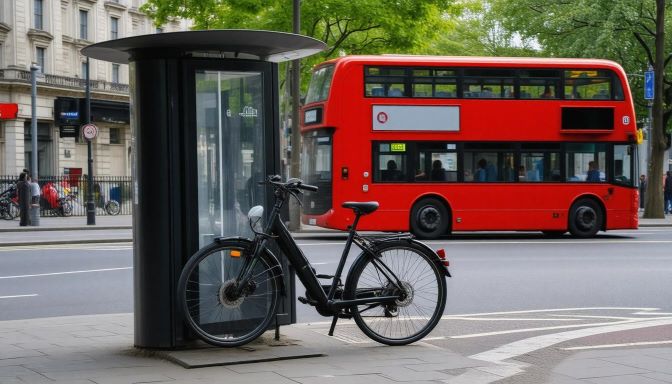
Time efficiency is a pivotal factor for daily commuters, and that’s where electric bikes (eBikes) can truly shine. Picture this: imagine setting off to work on an eBike during rush hour, weaving through traffic while the bus next to you crawls at a snail’s pace. Studies indicate that in urban areas, e-bikes can often outpace public transport options such as buses or trains.
For example, a 5-mile commute might take approximately 25 minutes by eBike but extend up to 40 minutes by bus due to frequent stops and traffic signals. This illustrates just how much we can save by opting for two-wheeled electrified propulsion over traditional commuting methods.
Many fellow commuters who have switched to eBiking report significant time benefits. The Edinburgh Council observed that in a three-month period, eBikes helped reduce average commute times by around 15%. That simple statistic speaks volumes: choosing an eBike means achieving more in less time.
We can touch upon how for individuals balancing work commitments with personal responsibilities, these savings provide invaluable opportunities. Imagine gaining back precious minutes to spend with family or pursuing hobbies simply by changing your mode of transport.
However, it’s essential to remember that these benefits hinge on suitable cycling infrastructure. Many urban areas are enhancing their bike paths and lanes, fostering safer environments for cyclists. In regions lacking such facilities, the potential efficiency gains of an eBike might not be fully realized.
Additionally, let’s weigh this against public transport timelines. Buses often come with their own schedules and potential delays complaints ranging from overcrowding to late arrivals plague many cities but they also carry the weight of fixed routes that can limit convenience.
With an eBike, we enjoy unparalleled freedom; we’re not confined to bus routes or train schedules, enabling us to navigate directly to our destinations with ease. If we need to pick a detour or avoid a congested area entirely, that becomes readily achievable on a pedal-assist bike.
Of course, personal experiences may vary based on individual circumstances such as trip distance or local weather conditions. Riders should consider factors like whether they feel comfortable riding in inclement weather or challenging terrain since these elements can influence commute choices.
Understanding the nuances of travel time paves the way for exploring another critical aspect of commuting the positive impact on overall well-being and physical health.
